by F.B. Peairs and J.L. Capinera * (9/14)
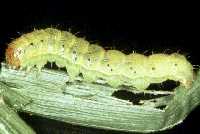
Quick Facts…
- Many species of caterpillars attack Colorado crops; the species involved will affect control decisions. Use the following descriptions to identify pests.
Corn Earworm or Tomato Fruitworm
Heliothis zea (Boddie). These caterpillars range in color from light green (light phase) to almost black (dark phase). Stripes also vary, but there usually is a pair of narrow dark lines down  the middle of the back and broad dark bands on each side.
the middle of the back and broad dark bands on each side.
The head is yellow or orange with a light net-like pattern. Most distinctive are the many microspines on the skin, as seen with a hand lens. This insect attacks a wide variety of field and vegetable crops, with sweet corn, tomato and soybean most important in Colorado. Damage is caused by feeding on ear tips, fruit, pods and blossoms. Corn earworm does not overwinter in Colorado. Egg laying activity usually occurs in July.
Western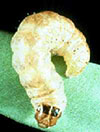 Bean Cutworm
Bean Cutworm
Loxagrotis albicosta (Smith). This small brown caterpillar is identified by faint diamond markings on the back. Mature larvae are brown to pale grey with dark brown bands behind the head. Ear tips are preferred in corn and developing pods in beans. This insect overwinters in Colorado, although egg laying does not occur until late July.
Saltmarsh Caterpillar
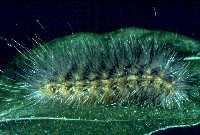
Estigmene acrea (Drury). These caterpillars are similar in appearance to the yellow woolly-bear caterpillar, except the saltmarsh caterpillar has a black head while the yellow woolly-bear has a yellow head. Both are distinguished from other crop caterpillars by their long dense hairs. Many garden crops are attacked, although bean and sugarbeet infestations are most important in Colorado. Two generations occur per year in Colorado, with most important damage occurring in August.
Armyworm
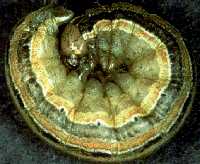
Psuedaletia unipuncta (Haworth). The head has dark net-like markings on a light brown background. Dark brown bars diverging above the mouth are present on the head capsule. Alternate light and dark stripes are present on the abdomen and an orange stripe on each side. The armyworm prefers grass crops such as corn, small grains and milo (sorghum), but some broadleaf crops may occasionally be damaged. Larvae are usually found in sheltered locations or below the soil surface during daylight. Several generations occur per year with the first damage occuring very early in the growing season.
Zebra Caterpillar
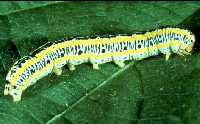
Melanchra picta (Harris). This insect is easily distinguished from other crop caterpillars by two bright yellow stripes running along each side of the body and separated by alternating black and white stripes running around the body. This insect can be found defoliating a variety of broadleaf field and vegetable crops, ornamental trees and flowers. It is generally not considered to be a serious pest. Damage from these insects can be expected in late May and June and again in late August and September.
Clover Cutworm
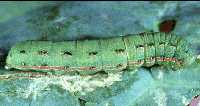
Scotogramma trifolii (Hufnagel). This is a greenish or brown climbing cutworm with a broad pink or yellow stripe on either side of the body. The abdominal spiracles are surrounded by black. Elongate black spots are sometimes found on the back. This insect is mostly important as a defoliator of sugarbeet, but has damaged clover. The clover cutworm has two to three generations per year in Colorado.
Beet Armyworm
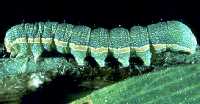
Spodoptera exigua (Hubner). A greenish striped caterpillar closely resembling the clover cutworm but lacking the black markings around the abdominal spiracles. This insect will attack a variety of broadleaf and grass crops, but sugarbeet is a preferred host. The beet armyworm has two to three generations per year in Colorado.
Alfalfa Caterpillar

Colias eurytheme (Boisduval). This caterpillar is dark green with a narrow white stripe on each side of the body and a fine red line running through the stripe. The alfalfa caterpillar is distinguished from other Colorado crop caterpillars by short, dense, velvet-like hairs covering the head and body. Occasionally, this caterpillar will be found in other leguminous crops but is primarily an alfalfa pest. Infestations are foretold by swarms of yellow butterflies, the adult stage. Several generations occur per year in Colorado.
* F.B. Peairs, Colorado State University Extension entomologist and professor, and J.L. Capinera, former professor; bioagricultural sciences and pest management. 1/92. Revised 9/14.
Colorado State University, U.S. Department of Agriculture, and Colorado counties cooperating. CSU Extension programs are available to all without discrimination. No endorsement of products mentioned is intended nor is criticism implied of products not mentioned.
Go to top of this page.





